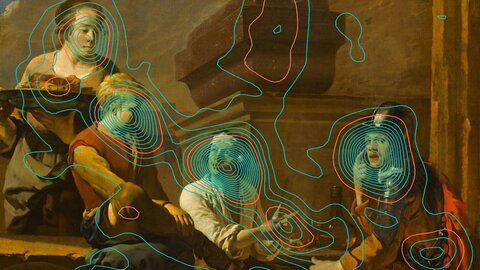True crime podcasts: testing the boundaries of journalism

In many countries, including Austria, journalism is an occupation that requires no license. Anyone who publishes something can call themselves a journalist. The flood of online publications not only constitutes strong competition for traditional media, it also makes it increasingly difficult to distinguish between journalistic and non-journalistic content. This comes with consequences for the credibility of the media sector.
Journalists and media professionals are forced to constantly renegotiate boundaries and demarcations according to journalistic standards. Known as “boundary work” in journalism research, this process is at the center of the FWF-funded project “From core to periphery: boundaries of journalism”, which is set to run until the end of 2025.
In this project, Folker Hanusch from the Institute of Journalism Studies at the University of Vienna and his team are investigating how new, “peripheral” formats are perceived and how they rank themselves: how do established media react to “newcomers” that challenge traditional journalism with their novel practices, values and types of narrative? Do those publishing media that are active solely on social media or corporate publishers define themselves as engaging in “journalism”? And how do media users assess digital offerings, from YouTube videos to blogs and podcasts?
The project
The FWF project “From the Core to the Periphery: Frontiers of Journalism”, led by Folker Hanusch from the University of Vienna, is being funded with EUR 368,000. The project explores the evolution of journalistic legitimacy in a digital media society.
Publication
True crime as a case study
Part of the FWF-funded project was dedicated to podcasts. Viennese journalism expert Phoebe Maares and US media researcher Gregory Perreault analyzed successful US true-crime productions. “Podcasts are an increasingly relevant field that is still under-researched,” says Maares, explaining her choice, “and true-crime podcasts are a particularly lucid illustration of how boundary discourse works.”
Following its start with the US production Serial in 2014, the format has developed into a global media phenomenon. The four seasons of the podcast that have been released so far have been downloaded over 340 million times and are considered a milestone in narrative journalism. (NB: several of the criminal cases covered were reopened after being featured in the podcast. In 2020, the New York Times bought the podcast's production company.) In meta-journalistic discourse, however, true-crime podcasts are still rejected as tasteless, superficial or sensationalist.
For the study, which has just been published in the journal Journalism Studies, the researchers selected six productions that cover a broad range from independent podcasters to established media houses, all of which enjoy a wide reach and popularity.
The team explored how the hosts present themselves within the podcasts, which journalistic practices they use in order to underpin the truth of their content, among other things, and how they deal with ethical aspects.
Most podcasters see themselves as journalists
In terms of methodology, the team first listened to all podcasts in their entirety in order to identify content categories: how do the hosts present themselves? What journalistic tools do they use? How do they deal with original sources – and how do they reflect on problematic aspects? In a second step, Maares and Perreault conducted an in-depth analysis of three episodes per podcast – almost 14 hours of material in total.
The evaluation revealed that four of the six podcasts explicitly define themselves as journalistic through their connection to a large media company, or through their self-presentation as journalists or by referring to editorial routines. Five formats make their approach transparent (they comment on sources, explain research routes and address uncertainties).
Contextualizing critical content
There are, however, considerable differences when it comes to how the podcasts approach ethical issues. “True crime is particularly challenging in this respect, because the podcasters delve very deeply into the cases,” says Maares, who used to be a journalist herself. A number of problems were identified. The consent of the people involved is not always sought for the publication of sensitive audio material, such as emergency calls, police interrogations or interviews. In some cases the narrative is driven forward “for its own sake” or perpetrators are allowed to make statements that are left uncommented – which is particularly problematic if the individual is charismatic.
“Podcasters who are aware of their journalistic responsibility will always contextualize their material,” Maares says with conviction. That is to say they will not simply leave recordings and statements to stand by themselves, but will include them in so-called meta-commentaries that either reflect on the podcaster’s own role or highlight problems.
Gray area with “soft boundaries”
As a matter of fact, Maares and Perreault found many such metanarratives in almost all podcasts. Conversely – and that came as quite a surprise – even established media houses sometimes fail to comply with journalistic standards. In one episode of the award-winning Serial podcast, for example, a protagonist was outed posthumously, even though this aspect was not relevant to the story.
The researchers conclude that true-crime podcasts operate in a journalistic gray area with “soft boundaries”: They use journalistic methods, but deviate from strictly defined norms of journalism in their narrative forms that are often subjective.
“Our study is a theoretical contribution to the boundary discourse in journalism,” notes Maares, “and – like the entire project – it is intended to be non-judgemental.” This said, the ethical and methodological questions raised are also likely to be relevant for (true crime) podcasters who consider themselves as being journalists.
About the researcher
Phoebe Maares holds a postdoc position at the Institute for Journalism and Communication Studies at the University of Vienna in the context of the FWF project “From core to periphery: boundaries of journalism”. Her research focuses on journalistic boundaries, the socio-economic conditions of journalistic work and power relations in journalism. Maares studied communication sciences in Vienna and worked as a journalist for the ORF radio station Ö1 and as editor-in-chief of the university station Radio Campus.





